- Author Rachel Wainwright [email protected].
- Public 2023-12-15 07:39.
- Last modified 2025-11-02 20:14.
Ubistezin
Ubistezin: instructions for use and reviews
- 1. Release form and composition
- 2. Pharmacological properties
- 3. Indications for use
- 4. Contraindications
- 5. Method of application and dosage
- 6. Side effects
- 7. Overdose
- 8. Special instructions
- 9. Application during pregnancy and lactation
- 10. Use in childhood
- 11. In case of impaired renal function
- 12. In case of impaired liver function
- 13. Use in the elderly
- 14. Drug interactions
- 15. Analogs
- 16. Terms and conditions of storage
- 17. Terms of dispensing from pharmacies
- 18. Reviews
- 19. Price in pharmacies
Latin name: Ubistesine
ATX code: N01BB58
Active ingredient: articaine + epinephrine (articaine + epinephrine)
Producer: 3M Deutschland GmbH (Germany)
Description and photo update: 2018-26-10
Prices in pharmacies: from 2834 rubles.
Buy

Ubistezin is a combined drug for local anesthesia for minor surgical interventions, including in dentistry.
Release form and composition
Dosage form Ubistezin - solution for injection: clear liquid, colorless and odorless (1.7 ml in cartridges, sealed with corks on both sides; in a tin can of 50 cartridges).
Composition of Ubistezin (1 ml solution):
- active substance: articaine hydrochloride - 40 mg, epinephrine hydrochloride - 0.0061 (equivalent to epinephrine - 0.005 mg);
- auxiliary components: sodium sulfite (equivalent to SO 2 - 0.31 mg), sodium chloride, water for injection.
Pharmacological properties
Pharmacodynamics
Ubistezin is a combined drug, the action of which is due to the properties of its constituent components:
- articaine: a local anesthetic of the thiaphene group characterized by its rapid onset of action (0.5-3 minutes after administration), lasting up to 45 minutes. In comparison with lidocaine, the effect of articaine is 2 times stronger, in addition, it is less toxic and faster excretion from the body. Does not slow down wound healing. Approved for use in children from 4 years of age and in elderly patients;
- epinephrine: a vasoconstrictor that prolongs the effect of the anesthetic by narrowing the blood vessels and slowing its absorption. Also, vasospasm leads to tissue hypoxia, suppressing the excitability of nerve endings, thereby reducing pain sensitivity. At the same time, the amount of epinephrine in Ubistezin is quite small and does not cause such disorders on the part of the cardiovascular system as increased blood pressure (BP) and tachycardia.
Pharmacokinetics
The penetrating power of articaine is high. The connection with plasma proteins is 95%. The substance practically does not penetrate the placental barrier, is not excreted in breast milk. The half-life is 22-25 minutes.
Indications for use
According to the instructions, Ubistezin is indicated for infiltration and conduction anesthesia (especially in patients with somatic diseases), for example, for uncomplicated extraction or grinding of teeth, filling, blockages of the trigeminal nerve, stellate ganglion, external genitalia, brachial plexus.
Contraindications
Absolute contraindications:
- deficiency of cholinesterase activity;
- hemorrhagic diathesis;
- severe liver failure;
- porphyria;
- hypertrichosis;
- angle-closure glaucoma;
- heart disease (condition after myocardial infarction or coronary artery bypass grafting, unstable angina pectoris, severe, uncontrolled arterial hypertension or hypotension, uncontrolled severe heart failure, tachycardia, uncontrolled severe cardiac conduction disturbances);
- the inflammatory process at the site of the alleged anesthesia;
- bronchial asthma with hypersensitivity to sulfites;
- cardiogenic shock;
- age up to 4 years;
- increased sensitivity to the components in the composition of Ubistezin, sulfites.
Relative contraindications:
- arterial hypertension, atherosclerosis, angina pectoris, intraventricular and atrioventricular block I degree, chronic heart failure;
- pheochromocytoma;
- blood clotting disorders;
- epilepsy;
- diabetes;
- bronchial asthma;
- hepatic / renal failure;
- elderly age;
- general severe and weakened condition.
Instructions for the use of Ubistezin: method and dosage
In the case of uncomplicated tooth extraction, 1.7 ml of Ubistezine is injected into the submucosa in the transitional fold from the vestibular side (for each tooth). In some cases, to achieve complete anesthesia, additional administration of 1-1.7 ml of the drug is possible.
For palatal incisions and sutures, about 0.1 ml of Ubistezine is administered to create a palatal depot. In the absence of inflammation and the need to remove the lower premolars, mandibular anesthesia can be dispensed with, as a rule, infiltration anesthesia is sufficient (1.7 ml per tooth, or, if necessary, up to 3.4 ml). A mandibular nerve block is only performed when complete anesthesia has not been achieved.
To prepare a tooth for filling or processing under a crown (except for lower molars), the drug is used at a dose of 0.5-1.7 ml / tooth, depending on the depth and duration of the procedure. Intrapulpal anesthesia lasts at least 45 minutes, soft tissue anesthesia - 120-240 minutes.
During tonsillectomy, 5-10 ml of the drug is injected into the amygdala, during suturing of the perineum - 5-15 ml, with conduction anesthesia - 1-30 ml (depending on the place and volume of anesthesia).
Side effects
- nervous system: headache; muscle tremor; involuntary muscle twitching, up to generalized seizures; violation of consciousness, up to its loss; respiratory failure, up to and including stopping it;
- digestive organs: nausea / vomiting, diarrhea;
- cardiovascular system: moderate hemodynamic disturbances (decreased blood pressure, tachycardia, bradycardia, depression of cardiovascular activity);
- allergic reactions: redness, itching of the skin, conjunctivitis, rhinitis, angioedema, anaphylactic shock;
- local reactions: inflammation or edema at the injection site, the appearance of ischemic zones in the meta of administration (in the case of unintentional intravascular administration, up to tissue necrosis).
Overdose
Symptoms of an Ubistezine overdose: dizziness, motor restlessness, tachycardia, bradycardia, impaired consciousness, decreased blood pressure.
Therapy of the condition: stopping the administration of the drug, giving the patient a horizontal position, ensuring free airway; in the process, it is necessary to control the heart rate (HR) and blood pressure.
Treatment of special conditions in case of overdose:
- respiratory failure: artificial lung ventilation, oxygen;
- convulsions: intravenous (IV) administration of barbiturates;
- shock: the introduction of electrolytes, glucocorticosteroids;
- vascular collapse: intravenous adrenaline injection - 0.1 mg;
- tachycardia: intravenous administration of selective beta-blockers;
- increased blood pressure: peripheral vasodilators.
special instructions
It is forbidden to inject Ubistezin intravenously, as well as to use the drug at the site of inflammation. The anesthetic contains sulfites that can enhance the anaphylactic reaction.
It is recommended to take food after sensitivity is restored.
Use only new and sterile syringes and needles each time you draw up solution. An open cartridge should not be reused due to the risk of hepatitis. It is also unacceptable to use the drug from a damaged cartridge.
Influence on the ability to drive vehicles and complex mechanisms
Due to preoperative anxiety and stress, the doctor makes a decision on admitting a patient to drive vehicles and other complex mechanisms on an individual basis.
Application during pregnancy and lactation
Due to the lack of data on the effectiveness and safety of the drug during pregnancy, its use during this period is possible only if the expected benefit to the mother outweighs the possible risk to the fetus.
If it is necessary to use Ubistezin during lactation, it is recommended to skip one feeding after anesthesia, replacing it with an artificial one. Milk should be expressed and not used.
Pediatric use
Recommendations for dosage of the drug in children aged 4 to 18 years:
- body weight 20-30 kg: 0.25-1 ml;
- body weight 30-45 kg: 0.5-2 ml.
The maximum daily dose of the drug should not exceed 7 mg articaine / kg body weight (1 ml of the solution contains 40 mg of articaine).
The recommended maximum daily dose, depending on the child's body weight:
- 20-30 kg - 3.5 ml;
- 30-40 kg - 5.25 ml;
- 40-45 kg - 7.0 ml;
- 45-50 kg - 7.9 ml;
- 50-60 kg - 8.7 ml;
- 60-70 kg - 10.5 ml;
- 70-80 kg - 12.2 ml.
In children, infiltration anesthesia may be used instead of conduction anesthesia due to the lower bone density.
With impaired renal function
Patients with renal insufficiency may need to reduce the dose of the drug.
If liver function is impaired
Patients with hepatic impairment may need to reduce the dose of the drug.
Use in the elderly
A reduced dose of the drug is recommended for elderly patients with heart and kidney diseases due to the risk of its cumulation.
Drug interactions
The use of Ubistezine is contraindicated in combination with non-selective beta-blockers, monoamine oxidase inhibitors, tricyclic antidepressants.
Ubistezine is used with caution in combination with phenothiazine, cardioselective beta-blockers, antiplatelet agents and anticoagulants.
Vasoconstrictor drugs enhance and prolong the effect of Ubistezine.
Analogs
The analogues of Ubistezine are Alfacaine, Brilocaine-adrenaline, Ultracaine D-S, Primacaine, Ultracaine suprarenin, Cytocartin, etc.
Terms and conditions of storage
Store away from light, at a temperature not exceeding 25 ° C. Keep out of the reach of children.
Shelf life is 2 years.
Terms of dispensing from pharmacies
Dispensed by prescription.
Reviews about Ubistezin
Reviews about Ubistezine when used in dentistry are mostly positive. The drug quickly and reliably relieves pain, its toxic effect is less than that of other anesthetics, which is due to its rapid elimination.
Price for Ubistezin in pharmacies
The approximate price for Ubistezin 4% for 50 cartridges in a can is 1 840 rubles.
Ubistezin: prices in online pharmacies
|
Drug name Price Pharmacy |
|
Ubistezin forte 40 mg + 10 μg / ml solution for injection with epinephrine 1.7 ml 50 pcs. 2834 RUB Buy |

Maria Kulkes Medical journalist About the author
Education: First Moscow State Medical University named after I. M. Sechenov, specialty "General Medicine".
Information about the drug is generalized, provided for informational purposes only and does not replace the official instructions. Self-medication is hazardous to health!






